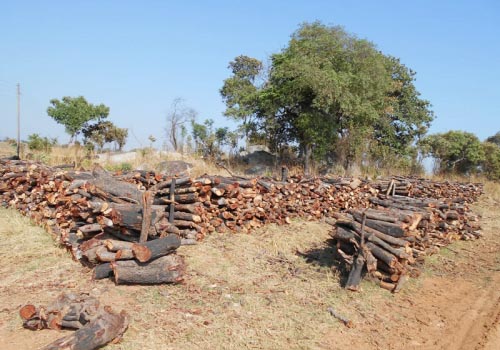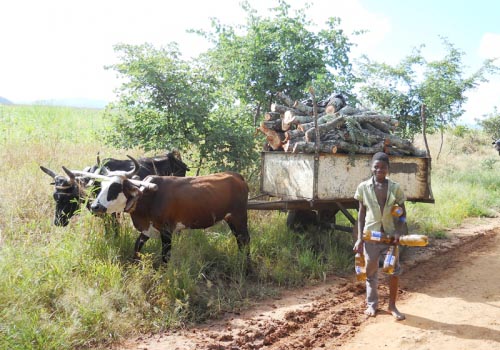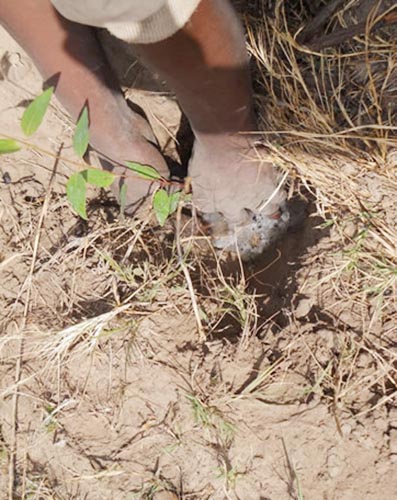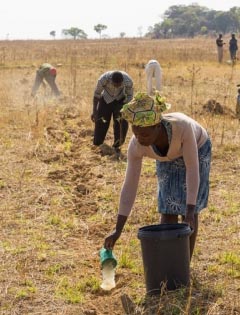
eBusiness Weekly


Indigenous wood stocked up for tobacco curing in Zimbabwe
Sydney Kawadza, Senior Writer
Horrendous figures coming out of Zimbabwe indicate the loss of about 330 000 hectares of forests annually due to a variety of activities including agriculture, domestic use and veld fires, leading to major tobacco companies such as Tian Ze Tobacco Company pushing for the protection of natural resources.
The rate at which Zimbabwe is losing its virgin forests has increased fears of serious desertification that has affected some parts of the country.
According to the Forestry Commission of Zimbabwe, the country has a forest resource covering approximately 45 percent of its surface area.
It, however, notes that 330 000 hectares of the forests are lost annually due to a variety of factors including clearing of land for agricultural expansion, settlement expansion, infrastructure development, firewood collection and tobacco curing.
The Forestry Commission further states that flue-cured tobacco curing contributes 15 percent of the aggregate deforestation rate in Zimbabwe.

Wood being transported for domestic use
Yet in the face of these horrific statistics are farmers like Agnes Kanhanga, a tobacco farmer who owns Stockwell Farm in Mvurwi, Mashonaland Central Province of Zimbabwe.
Kanhanga has grown to be a leading light in the tobacco industry as a beneficiary of the Tian Ze Tobacco Company’s contract farming programme in Zimbabwe.
Tian Ze Robacco company’s capital expenditure programme
Tian Ze, a subsidiary of the China National Tobacco Company, assists selected farmers with inputs which the latter pay for during the selling season. The company was established in April 2005 and is involved in tobacco contract growing, auction floor purchasing, warehousing and exporting to China.
In the SADC region, Tian Ze Tobacco supervises the sourcing of the tobacco leaf from Zambia, Malawi and Tanzania on behalf of the China National Tobacco Company.
For farmers like Kanhanga, Tian Ze has gone further and procured equipment such as centre pivots, tractors, trucks and other machinery that has seen their tobacco production capacity increase.
Kanhanga is one of the more than 150 tobacco farmers emerging from Zimbabwe’s land reform programme benefiting from Tian Ze. Under the CAPEX programme, Tian Ze has developed to be a major contributor to the growth of the tobacco industry which has seen exports rising beyond an average of US$600 million per season.
According to the Chinese Embassy in Zimbabwe, trade between Harare and Beijing has grown beyond the $1 billion mark with tobacco exports contributing 50 percent.
Environmental Impact
There are concerns, however, on the negative environmental impact of tobacco farming in Zimbabwe. According to Kanhanga, deforestation in Mashonaland Central is not as severe compared to other parts of Zimbabwe where forests are disappearing.
“We have not had much of a problem of deforestation in our province but the negative impact of tobacco farming has been felt across the country,” she explained.
Deforestation is defined as the removal of a forest stand, where the land is then put to a non-forestry use.
“Tobacco farmers, who need firewood for fuel during the curing of their tobacco, have caused untold damage to the environment especially when they cut indigenous trees for fuel wood,” Kanhanga said.
In Zimbabwe, the problem is threatening to decimate the country’s forests, leading to loss of bio-diversity, general land forest degradation, loss of animal habitats and reduction of water supply – both in terms of quality and quantity.
Other challenges caused by deforestation in Zimbabwe include desertification and the exacerbation of climate change that all negatively impact agricultural productivity.
As of 2015, there are approximately 100 000 registered tobacco farmers in Zimbabwe, with approximately 35 percent of them coming from Mashonaland West province, according to the Forestry Commission.
A further 29 percent of the tobacco farmers are based in Mashonaland Central while Manicaland and Mashonaland East have 19 percent and 17 percent, respectively.
Tawanda Mufudze of Lot 2 Avalon Farm in Hurungwe District in Mashonaland West Province, which the Forestry Commission indicates has the highest tobacco growers in Zimbabwe, believes communal farmers are contributing to deforestation.
Hurungwe District accounts for approximately 20 000 tobacco growers annually.
“As the numbers grow, you will notice that this has also created challenges such as deforestation which have become quite rampant, especially here in Hurungwe district,” he said.
Mafudze, is a beneficiary of Zimbabwe’s land reform programme at the turn of the millennium, receiving five hectares of land under the A1 model.
He explained the constraints to exploring alternative fuels that is experienced by farmers.
“There are other alternative sources of fuel such as coal but many communal farmers cannot afford these since their activities have not earned them much money,” he said.
Disappearing forests
According to Forestry Commission of Zimbabwe managing director Abedinico Marufu, the country loses about 330 000 hectares of forests due to a variety of factors.
“Using current conventional and commonly applied tobacco curing methods and technology, one would need approximately 20 cubic metres of stacked indigenous tree firewood to produce a tonne of cured tobacco.
“Wood volume would be slightly higher at about 23 cubic metres if firewood is of exotic trees such as Eucalyptus trees due to variances in heat energy outputs,” he said.
Marufu further states that research by the Tobacco Research Board indicates that there would be less requirements for firewood if farmers used heat efficient barns.
“Using a standard conversion factor of Eucalyptus wood weighing 425kg per stacked cubic metre of firewood at approximately 13 percent moisture content, this would convert to approximately 8,5-9,8kg of firewood required to produce 1kg of cured tobacco.
“Assuming that all 133 million kg of tobacco sold in the 2011 marketing season were cured using firewood, the national wood requirement for that season would have been between 1.1 and 1,3 billion cubic metres of firewood.
“The values would change under the influence of factors such as energy output of the type of wood used and efficiency of the curing system.”
He said coal requirements for tobacco curing have been determined to be ranging from 0.8 to 2,5kg of coal needed to produce one kilogram of cured tobacco.
Finding solutions
It is in this vain that the Forestry Commission has intensified afforestation programmes, which has seen the establishment of 60 district tree nurseries with a combined target of producing approximately 10 million tree seedlings for planting countrywide.
Government, through the National Budget of 2015, re-introduced the Tobacco Levy Fund, with each tobacco producer required to contribute 1.5 percent of the sales towards re-afforestation activities.
In the 2016 and 2017 selling seasons, the deductions were reduced to 0,75 percent of the sale proceeds. Marufu said while they believe deductions have been implemented since 2015, the Forestry Commission did not receive any money from the fund.
However, in an interview, Finance and Economic Development Minister Patrick Chinamasa said the deductions would be discontinued as Government wanted to promote increased tobacco production.
 “We want to incentivize tobacco production and it would be counterproductive to tax the farmers when the thrust is to promote increased production,” he said.
“We want to incentivize tobacco production and it would be counterproductive to tax the farmers when the thrust is to promote increased production,” he said.
The Tobacco Industry and Marketing Board (TIMB), which was facilitating the deductions for the Tobacco Levy Fund, said they had put up programmes to fight the scourge while trying to avert desertification.
TIMB spokesperson Isheunesu Moyo said the resources raised for the Fund were ring fenced for reforestation programmes in tobacco growing areas.
“The TIMB together with tobacco merchants established a fund in 2013 and formed a Trust known as the Sustainable Afforestation Association that is funded by the Fund.
“To date 14 000 hectares have been planted for wood energy to cure tobacco. Tobacco contracting merchants are implementing reforestation programmes with their contracted farmers,” he said.
Moyo said since 2014, the TIMB has funded small-scale farmers to construct fuel efficient barns that use 50 percent less firewood. He said the board had also mobilised $2m from its own resources for planting of trees for curing tobacco.
“The target is for each of the four main tobacco growing provinces to plant 400 hectares at a budget of US$500 000.”
Moyo, however, said the TIMB hasn’t started to use the fund as it is waiting for administrative processes and approval from the Parliament of Zimbabwe.
“We want to scale up our activities and increase to 20 000 hectares of woodlots per year for the next five years. That would be enough to cure 100 000 hectares of tobacco per year,” he said.
In 2016, Moyo said, the Global Tobacco Cigarette Companies produced guidelines on the sustainable manner tobacco is supposed to be produced.
“As from 2020, Global Cigarette companies will not buy tobacco that has not been produced in a sustainable manner, including that which is cured using coal.
“As a result it is imperative for the industry to adopt aggressive afforestation programmes in order to remain competitive and relevant to the Global Cigarette Industry.”
There are 27 tobacco companies contributing to the Sustainable Afforestation Association (SAA) of which Tian Ze is one of the major contributors annually.
According to Tian Ze managing director Ye Hai, the Chinese company sits on the SAA board contributing about US$8000 000 per year towards afforestation programmes.
“So far more than 15 000 hectares of forestry have been planted while the SAA is also carrying out community awareness on the importance of afforestation and veld firefighting training,” he said.

Community participation is critical in the afforestation programmes
According to the Sustainable Afforestation Association business relations manager Lloyd Mubaiwa the levy set at 1,5 percent of the tobacco merchants’ purchases had generated about US$8.9 million in 2017. The association had in 2016 raised US$65 million.
“Our focus has been to plant trees, with a further 3 397 hectares established in Mashonaland East, Central and West. In addition a further 7 200 hectares were maintained,” he said.
The association, Mubaiwa said, had also established 40 hectares under a community woodlot trial run in conjunction with Pfura Rural District Council in Mashonaland Central province.
“This pilot project proved successful and the scheme has been expanded in 2017 so that approximately 105 ha have been planted in Pfura and Makoni District of Manicaland, with projects showing encouraging survival rates.”
There are also plans to expand the community woodlot project to other tobacco growing areas in Zimbabwe. Mubaiwa said the committee set a target of 3 624 ha for the 2017/18 season, with a further 10 000 ha to be maintained.
The association has a forest area of 15 000 ha of Eucalyptus trees under its management.
“We have set a target of an incremental of more than 3 600 ha of new forests each season. These plantations are grown and managed in partnership with selected farmers with whom the association will share proceeds from fuel wood sales among tobacco farmers,” Mubaiwa said.
The plantations are usually harvested after every four years.
Tian Ze’s contribution
Since its establishment, Tian Ze has been providing interest free loans, free technical support, training and service to contracted farmers to help them improve tobacco production.
Over the years, the company has seen an increase of contracted farmers rising from just one farmer to more than 300 contractors. The hectarage has also risen from 26 to 9 900 ha.
“Ultimately, tobacco output from our contract scheme increased from eight tonnes to 27 000 tonnes. The tobacco quality has also been improved greatly with 84 percent of the contract crop now falling within the specs of Chinese type tobacco.
“Before Tian Ze came to Zimbabwe, the Zimbabwean tobacco market was dominated by a few players and the highest price was US$2,99 per kg.
“However, the coming in of Tian Ze increased the competition and pushed the price up thus increasing the benefit to the farmers. Consequently, Zimbabwe tobacco crop size increased from 48.8 million kg in 2008 to 217 million kilogrammes,” Ye said.
Besides contract farming and auction floor purchases, Tian Ze also sources tobacco from other merchants in Zimbabwe for export to China.
More than 50 percent of Zimbabwe’s tobacco is sold and exported to China annually.
China National Tobacco Company has also been buying 60 million packed tobacco from Zimbabwe worth US$400 million every year,
Tian Ze also supplies 20 million kg — about 30 percent of the Chinese market.
As the Zimbabwe’s tobacco farming continues to grow prospects of more forests being lost to the curing of the crop, the country is under threat from worsening deforestation.
It is, however, commendable that the tobacco industry has taken the initiative to protect the forests by planting fast growing and heat intensive alternative tree species such as the Eucalyptus trees.
The programme would also need support from Government and its development partners to protect forests and prevent further deforestation in tobacco growing areas.
This work was produced as a result of a grant provided by the Africa-China Reporting Project managed by the Journalism Department of the University of the Witwatersrand.


